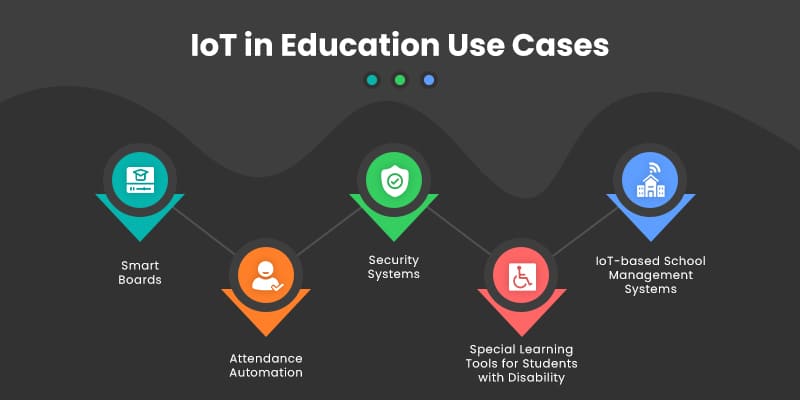Harnessing the Potential of IoT for a Smart Learning Experience
How can IoT be used in smart schools?
IoT-enabled smart campuses and schools provide students with an immersive, customised, and dynamic learning environment while boosting security, streamlining operations, and empowering administrators to make data-driven decisions.
What educational benefits may IoT offer society?
IoT has a huge impact on education since it can change how kids engage with their surroundings and learn. Students’ learning experiences can be made more interesting and personalised with the use of IoT, which can give them real-time support and feedback.
How might IoT help create a smart classroom?
Smart Classrooms: IoT-enabled classrooms with a variety of sensors and gadgets provide an engaging and productive learning environment. These classrooms have the ability to regulate temperature and lighting automatically, use less energy, and offer teachers and students uninterrupted connectivity.
Which educational applications of IoT are there?
IoT in education: real-world instances of interactive displays. Maybe we ought to begin by installing unique touchscreens, or touchpads, into students’ desks and teacher’s boards. Voice-to-text technologies; electronic bracelets; head sensors; smart classrooms; and cameras in classrooms.
How does the Internet of Things affect higher education?
Through the use of IoT, educational institutions can improve student learning by offering a more engaging curriculum, increasing operational effectiveness, and obtaining important real-time data on student performance.
Real-time asset/resource visibility.
Reduced costs.
Improved operational efficiency.
Data-driven insights for quick decision-making.
End-to-end, remote monitoring and management of assets/resources.
Real-time, predictive, and prescriptive insights.
Improve end-customer experience.
What are IoT’s main effects?
What Role Does the Internet of Things Play in the World? Task automation, enhanced environment security and safety in an emergency, energy efficiency, decreased carbon emissions, and industry-wide innovation are all impacted by the Internet of Things.
The integration of Internet of Things (IoT) devices and technology to improve educational processes and learning environments is known as the “Internet of Things” (IoT) in education. The following are some applications of IoT in education:
Smart Classrooms: Interactive whiteboards, smart projectors, and learning aids with IoT capabilities can all be combined to build connected, smart classrooms using IoT devices. These gadgets can support dynamic and participatory teaching strategies.
Analytics and Student Tracking: The Internet of Things can be used to monitor student behaviour and collect performance statistics. In the classroom, wearable technology and sensors can gather data on attendance, involvement, and engagement, giving teachers important new perspectives.
Improved Learning Environments: Personalised and adaptable learning environments can be made possible by IoT technologies. With the use of smart devices, education may be more individually personalised to each student by changing the content and pace of the lesson according to their needs.
Security and Safety: By implementing connected access control, emergency response systems, and smart surveillance systems, IoT can help improve campus security and safety. This guarantees a safe atmosphere for employees and students alike.
Resource Management: The Internet of Things facilitates effective resource management for education. Smart HVAC and lighting systems, for example, can optimise energy use and lower expenses for educational institutions.
Collaborative Learning: By bringing together students and teachers in disparate places, IoT can support collaborative learning activities. Collaboration tools and virtual classrooms can improve group work and communication.
The Internet of Everything (IoE) in Education: IoE is the networked connection of people, processes, data, and things. It goes beyond IoT. The entire educational ecology may be significantly improved by this extensive interconnectedness.
The goal of integrating IoT into education is to improve student engagement, personalisation, and efficiency while also solving a number of administrative and security issues.
What is the Internet of Things’ impact on education?
The study’s findings demonstrate how IoT devices and systems increase educational access. They democratise education and facilitate teaching and learning. Using IoT devices as teaching aids results in a very interesting learning experience for students.
What effects will IoT have down the road?
Major surveys predict that the worldwide IoT industry will expand at a compound annual growth rate (CAGR) of 26.1% to reach $3352.97 billion by 2030. The IoT market was estimated to be worth $742 billion in 2020 alone. It is anticipated that IoT usage will rise in several areas
What uses will IoT have in the future?
Internet of Things Uses in Smart Cities
A variety of sensors operating in diverse capacities are placed across the city to handle a range of activities like traffic control, trash management, streetlight optimisation, water conservation, energy expenditure monitoring, smart building creation, and more. healthcare, and transportation.
Source

